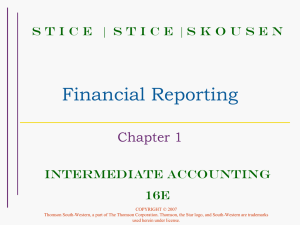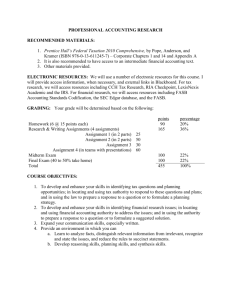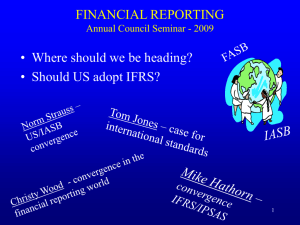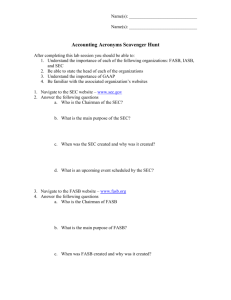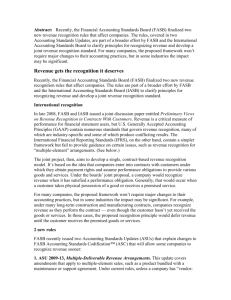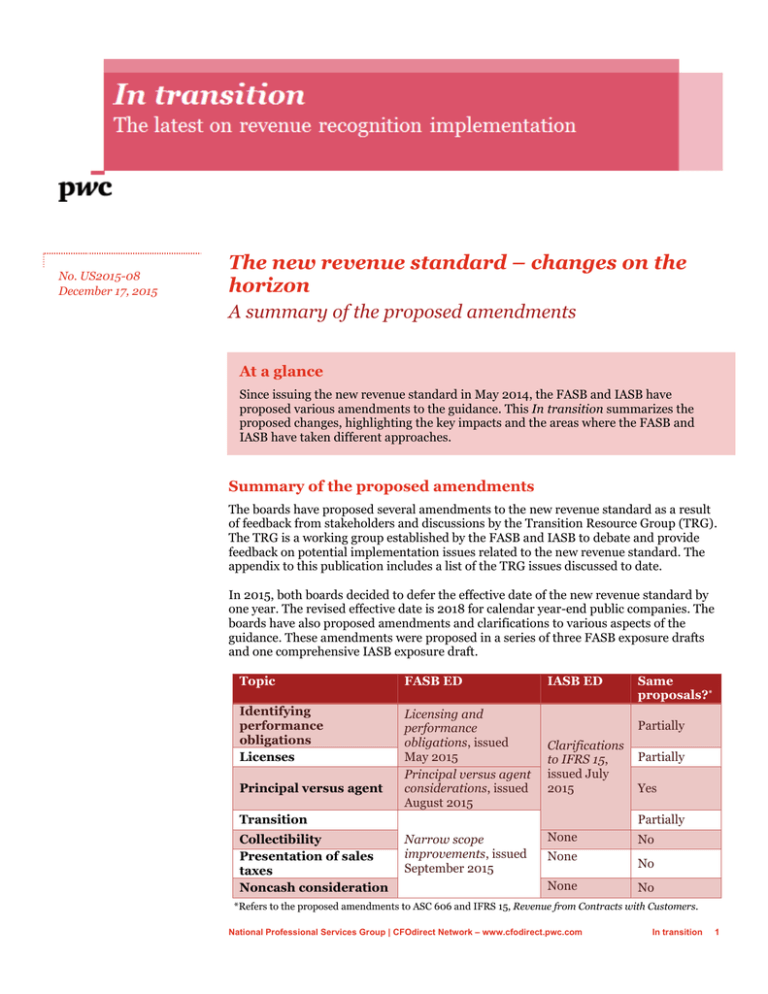
No. US2015-08
December 17, 2015
The new revenue standard – changes on the
horizon
A summary of the proposed amendments
At a glance
Since issuing the new revenue standard in May 2014, the FASB and IASB have
proposed various amendments to the guidance. This In transition summarizes the
proposed changes, highlighting the key impacts and the areas where the FASB and
IASB have taken different approaches.
Summary of the proposed amendments
The boards have proposed several amendments to the new revenue standard as a result
of feedback from stakeholders and discussions by the Transition Resource Group (TRG).
The TRG is a working group established by the FASB and IASB to debate and provide
feedback on potential implementation issues related to the new revenue standard. The
appendix to this publication includes a list of the TRG issues discussed to date.
In 2015, both boards decided to defer the effective date of the new revenue standard by
one year. The revised effective date is 2018 for calendar year-end public companies. The
boards have also proposed amendments and clarifications to various aspects of the
guidance. These amendments were proposed in a series of three FASB exposure drafts
and one comprehensive IASB exposure draft.
Topic
FASB ED
Identifying
performance
obligations
Licenses
Licensing and
performance
obligations, issued
May 2015
Principal versus agent
considerations, issued
August 2015
Principal versus agent
IASB ED
Partially
Clarifications
to IFRS 15,
issued July
2015
Transition
Collectibility
Presentation of sales
taxes
Noncash consideration
Same
proposals?*
Partially
Yes
Partially
Narrow scope
improvements, issued
September 2015
None
None
None
No
No
No
*Refers to the proposed amendments to ASC 606 and IFRS 15, Revenue from Contracts with Customers.
National Professional Services Group | CFOdirect Network – www.cfodirect.pwc.com
In transition
1
Identifying performance obligations
A key aspect of the new revenue standard is identifying the performance obligations, which are the unit of account for
applying the guidance. Various stakeholders provided feedback that it is not clear how to determine whether a good or
service is separately identifiable from other promises in a contract. Additionally, some stakeholders raised concerns
about the cost and complexity of applying the guidance to shipping and handling services, and immaterial performance
obligations. In response, the FASB proposed amendments to clarify its guidance. The IASB proposed more limited
changes to the related examples.
Issue
US GAAP – FASB proposals
IFRS – IASB proposals
Determining
whether a good or
service is
“separately
identifiable” from
other promises in
the contract
The FASB’s proposal clarifies the principle for
determining whether a good or service is
“separately identifiable” from other promises in
the contract. The revised principle states that
the objective is to determine whether the nature
of an entity’s promise is to transfer individual
goods or services to the customer, or to transfer
a combined item (or items) to which the
individual goods and services are inputs. The
FASB also proposed new examples and
amendments to the existing examples
illustrating these principles.
The IASB’s initial proposal did not include
changes to the principle in the guidance.
However, at its December 15, 2015 meeting,
the IASB decided to pursue further
convergence with the FASB’s proposed
language. The IASB also proposed to add new
examples, and amend existing examples, to
clarify how to apply the guidance. The new
and amended examples are similar, but not
identical, to those proposed by the FASB.
However, the IASB committed to working
with the FASB to pursue further convergence
on the examples.
Potential impact:
The FASB’s proposed amendments help clarify how to apply the guidance on identifying
performance obligations in various scenarios, such as when a vendor sells a piece of equipment
and a related installation service. The amendments may result in differences between the US
GAAP and IFRS standards. The boards have suggested that the financial reporting outcomes are
expected to be the same despite the potential differences.
Shipping and
handling activities
The FASB’s proposal would allow entities to
elect to account for shipping and handling
activities that occur after the customer has
obtained control of a good as a fulfilment cost
rather than an additional promised service.
The IASB did not propose a similar
amendment. Entities are therefore required to
consider whether shipping and handling
services give rise to a separate performance
obligation.
Potential impact:
The FASB’s proposed amendment would reduce the cost and complexity of applying the revenue
standard for some US GAAP reporting entities. However, the introduction of this election may
result in diversity in practice that could, in some instances, have a material impact to the
financial statements. It would also create a difference between entities applying US GAAP that
elect the expedient and entities applying IFRS.
Immaterial goods
or services
The FASB’s proposal clarifies that entities are
not required to identify promised goods or
services that are immaterial in the context of the
contract.
The IASB did not propose a similar
amendment; however, the IASB included
additional discussion in the basis for
conclusions stating that entities should
consider the overall objective of IFRS 15 as
well as materiality in identifying promised
goods or services in a contract.
National Professional Services Group | CFOdirect Network – www.cfodirect.pwc.com
In transition
2
Issue
US GAAP – FASB proposals
IFRS – IASB proposals
Potential impact:
The FASB’s intent is to not require US GAAP reporting entities to incur time and cost to identify
and track immaterial items. The IASB did not propose a similar amendment; however, the IASB
has indicated that IFRS does not require entities to account for immaterial items.
Next steps:
The comment period for the FASB’s exposure draft ended on June 30, 2015. The FASB redeliberated its proposal in
October, affirming its decisions on the above matters. The FASB also decided that if revenue is recognized before
shipping and handling services are performed or the transfer of immaterial goods or services, entities should accrue
the related costs. The FASB directed the staff to draft a final Accounting Standards Update (“ASU”).
The comment period for the IASB’s exposure draft ended on October 28, 2015. The IASB redeliberated its proposal in
December and generally affirmed its decisions on the above matters, but agreed to pursue further convergence with
the FASB on amendments to the “separately identifiable” guidance and related examples. The IASB expects to issue its
final amendments in 2016.
Licenses
The new revenue standard includes specific guidance on the accounting for licenses of intellectual property (“IP”). This
guidance addresses whether the license is a right to access or a right to use the entity’s IP, which determines whether
revenue is recognized over time or at a point in time. The standard also states that revenue from sales-based and usagebased royalties promised in exchange for a license of IP should not be recognized until the subsequent sale or usage
occurs. This is an exception to the general guidance for variable consideration, which requires entities to estimate
variable fees, subject to a constraint.
The license guidance has raised a number of questions and implementation challenges. These include:
How to determine the nature of an entity’s promise in granting a license; that is, whether the license is a right to
access or a right to use IP
Whether the sales-based and usage-based royalty exception applies where the royalty relates to both a license
and other goods or services
Whether restrictions of time, geography, or use in a license impact the number of promises in the contract; that
is, whether a contract can include multiple distinct licenses
How to apply the license guidance in the event a license is not distinct from other goods or services
As a result, both the FASB and IASB proposed amendments to the license guidance.
Issue
US GAAP – FASB proposals
IFRS – IASB proposals
The nature of a
company’s promise
in granting a
license
Under the FASB’s proposal, licenses would be
classified as either “symbolic” IP (for example,
brand names or logos) or “functional” IP (for
example, software or completed media content).
All licenses of symbolic IP would be recognized
over time as a “right to access” license.
Functional IP would be recognized at a point in
time as a “right to use” license unless the
functionality of the IP is expected to
substantively change as a result of activities of
The IASB proposed limited amendments to
clarify the existing principle. The proposal
clarifies that an entity’s activities significantly
affect the IP (a criterion to determine if the
license is a “right to access” IP) if (a) the
entity’s activities change the form or
functionality of the IP or (b) the utility of the
IP is substantially derived from or dependent
upon those activities (e.g., a brand name). The
IASB also proposed amendments to the
National Professional Services Group | CFOdirect Network – www.cfodirect.pwc.com
In transition
3
Issue
US GAAP – FASB proposals
IFRS – IASB proposals
the entity that do not transfer a good or service
to the customer. The FASB also proposed new
examples and amendments to the existing
examples.
existing examples to illustrate the clarified
principle.
Potential impact:
The FASB’s proposal is intended to make the guidance more operational and reduce diversity by
establishing a “bright line” between functional and symbolic IP. The amendments would result
in divergence between the US GAAP and IFRS standards. The boards have indicated that they
believe the financial reporting results will be the same in most cases. We believe there will be
some instances where the conclusion would differ under US GAAP and IFRS. For example,
under US GAAP, revenue from a license of symbolic IP would be recognized over time even if the
licensor is clearly performing no activities related to the IP. The licensor would recognize
revenue at a point in time under IFRS, however, since it is no longer supporting the IP.
The exception for
licenses of IP with
sales- and usagebased royalties
The FASB’s proposal would not require an
The IASB proposed the same amendment.
entity to split a royalty into the portion that is
subject to the royalty exception and the portion
that is not. The amendment clarifies that the
royalty exception applies when the predominant
item to which the royalty relates is a license.
Potential impact:
The boards’ proposal helps clarify in which circumstances the royalty exception applies. The
boards do not intend to provide further guidance on the definition of “predominant,” so this
assessment will require judgment.
Determining
whether
contractual
restrictions impact
the number of
promises in a
contract
The FASB proposed an amendment to clarify
that contractual restrictions of time, geography,
or use are attributes of the license and do not
affect the number of promised goods or services
in a contract.
The IASB did not propose a similar
amendment; however, the IASB included
additional discussion in the basis for
conclusions stating that restrictions of time,
geography, or use are attributes of the license
and do not affect the number of promised
goods or services in a contract.
Potential impact:
There continues to be debate regarding how the guidance on restrictions should be interpreted.
The topic was discussed at the TRG’s November meeting where TRG members expressed
differing views. The guidance in this area will have a significant impact to entities that license IP
if those licenses contain contractual restrictions.
Determining
whether the license
guidance applies
when the license is
not distinct
The FASB’s proposal clarifies that an entity may
need to consider the nature of a license, even if
it is not distinct from other goods or services in
the contract. An example is a ten-year term
license that is combined with a two-year service
into a single performance obligation. In that
situation, it could be necessary to assess
whether the license is a “right to use” IP
(revenue recognized at a point in time) or a
The IASB did not propose a similar
amendment; however, the IASB included
discussion in the basis for conclusions stating
that, in some cases, an entity might need to
consider the nature of its promise in granting
a license, even when the license is not distinct.
National Professional Services Group | CFOdirect Network – www.cfodirect.pwc.com
In transition
4
Issue
US GAAP – FASB proposals
IFRS – IASB proposals
“right to access” IP (revenue recognized over
time) to determine the pattern of recognition
for the combined performance obligation.
Potential impact:
The FASB’s and IASB’s guidance would differ in this area; however, we do not believe the
different wording will result in significant differences in accounting conclusions.
Next steps:
The comment period for the FASB’s exposure draft ended on June 30, 2015. The FASB redeliberated its proposal in
October, affirming its decisions on the majority of the above matters. As noted above, the impact of license restrictions
continues to be debated and was recently discussed at the TRG’s November meeting. We expect the boards to discuss
this issue further as they finalize their proposed amendments to the licensing guidance.
The comment period for the IASB’s exposure draft ended on October 28, 2015. The IASB redeliberated its proposal in
December, largely affirming its decisions on the above matters. The IASB expects to issue its final amendments in
2016.
Principal versus agent
When more than one party is involved in a revenue transaction, the new revenue standard requires an entity to
determine whether it is the principal (providing the goods or services itself) or an agent (arranging for another party to
provide those goods or services). A principal reports revenue based on the gross amount received from the customer
and an agent reports only its fee or commission (that is, net of the amount it remits to the other party). The standard
states that an entity is a principal if it controls a good or service before it is transferred to the customer. Stakeholders
expressed concerns with how to identify the unit of account for the assessment, how to apply the control principle to
services, and the relationship between the control principle and the indicators in the guidance. As such, both boards
agreed to make targeted improvements to clarify the guidance and the related examples.
Issue
US GAAP – FASB proposals
IFRS – IASB proposals
Identifying the
“unit of account”
for the principal
versus
agent assessment
The FASB’s proposal clarifies the “unit of
The IASB proposed the same amendments.
account” for the principal versus agent
assessment and requires an entity to first
identify the specified good or service being
provided to the customer. The amendments
clarify that an entity may be a principal for one
or more specified goods or services in a contract
and an agent for others.
Applying the notion
of control to
services performed
by another party
The FASB’s proposal clarifies that a principal
can control a service if it directs another party
to perform the service for the customer on its
behalf. The proposal also clarifies that an entity
can control a good or service when it provides a
significant service to integrate other goods or
services into the specified good or service for
which the customer has contracted.
The relationship
between the notion
The FASB’s proposal clarifies that the indicators The IASB proposed the same amendments.
assist an entity in evaluating whether it controls
The IASB proposed the same amendments.
National Professional Services Group | CFOdirect Network – www.cfodirect.pwc.com
In transition
5
Issue
US GAAP – FASB proposals
of control and the
indicators
a good or service before it is transferred to a
customer (that is, the indicators do not override
or replace the control evaluation). The proposal
reframes the existing indicators to provide
evidence of when an entity is a principal, rather
than when an entity is an agent, and to add
explanatory language on how each indicator
supports the control evaluation.
IFRS – IASB proposals
Potential impact:
We do not expect that the proposed amendments would result in pervasive changes in gross
versus net reporting conclusions as compared to existing guidance. It is possible, however, that
some conclusions could change under the new revenue standard based on the control principle
and other clarifications to the guidance. Entities should plan sufficient time to review and
understand the terms of their contracts with customers and vendors, which can often be
complex, to ensure appropriate conclusions are reached under the new revenue standard.
The boards have remained converged in their proposed amendments to the standard relating to
principal versus agent considerations. However, the boards included differing discussion in the
basis for conclusions regarding the accounting by an entity that is a principal, but does not know
the price for which the intermediary (agent) sells goods or services to the customer. The FASB’s
discussion suggests the principal should generally recognize revenue equal to the amount it
receives from the intermediary (i.e., on a net basis), while the IASB’s discussion suggests it could
be appropriate for the principal to estimate the transaction price.
Next steps:
The comment periods for the FASB’s and IASB’s exposure drafts ended on October 15 and 28, respectively. The boards
jointly redeliberated the principal versus agent proposals in December, and largely affirmed their decisions on the
above matters. At that meeting, the boards voted to eliminate the “credit risk” indicator because it does not readily
link to the control principle and is typically less relevant to the evaluation. Both boards expect to issue their final
amendments in 2016.
Transition
The new revenue standard includes two transition alternatives: the modified retrospective transition approach and the
full retrospective transition approach. The standard also includes some practical expedients to simplify transition. Both
boards proposed clarifications and new practical expedients in response to stakeholder feedback in order to further ease
transition.
Issue
US GAAP – FASB proposals
IFRS – IASB proposals
Contract
modifications
The FASB proposed a “use of hindsight”
practical expedient intended to simplify the
transition for contracts modified multiple times
prior to the initial application of the standard.
An entity applying the expedient would
determine the transaction price of a contract at
the date of initial application and perform a
single, standalone selling price allocation (with
the benefit of hindsight) to all of the satisfied
The IASB proposed the same practical
expedient; however, the date the expedient is
applied is the beginning of the earliest period
presented. At its December 15, 2015 meeting,
the IASB decided to allow entities, as an
alternative, to apply this practical expedient at
the date of initial application.
National Professional Services Group | CFOdirect Network – www.cfodirect.pwc.com
In transition
6
Issue
US GAAP – FASB proposals
IFRS – IASB proposals
and unsatisfied performance obligations in the
contract from inception.
Potential impact:
The boards have made similar, but not identical, proposals intended to ease transition for
contracts that have been modified multiple times. The difference in the proposals is primarily
that the FASB proposed one date at which the expedient can be applied, whereas the IASB will
permit a choice of dates at which the expedient can be applied.
Completed
contracts at
transition
An entity using the modified retrospective
transition approach will not apply the new
standard to contracts that are complete as of the
date of initial application. The FASB’s proposed
amendments change the definition of a
“completed contract” to a contract for which all,
or substantially all, of the revenue was
recognized under previous revenue guidance
before the date of initial application.
Additionally, the proposed amendments would
permit entities to apply the new standard to
either all contracts or only contracts that are not
complete under the modified retrospective
transition approach.
The IASB did not propose a change to the
definition of completed contracts. A
completed contract is a contract for which the
entity has transferred all of the goods or
services identified in accordance with previous
revenue guidance. At its December 15, 2015
meeting, the IASB voted to permit entities to
apply the new standard either to all contracts
or only contracts that are not complete under
the modified retrospective transition
approach.
The IASB also proposed to permit entities
using the full retrospective transition
approach to not restate contracts that are
completed contracts as of the beginning of the
earliest period presented.
Potential impact:
The FASB’s proposal to change the definition of a “completed contract” is intended to resolve
certain implementation issues that were raised at the TRG’s July meeting. The different
definitions of a "completed contract," however, could lead to reduced comparability between US
GAAP and IFRS reporters upon transition. More contracts are likely to meet the IASB’s
definition of a completed contract than the FASB’s definition. Further, IFRS reporters might
encounter fact patterns where they will continue to recognize revenue based on the previous
revenue guidance related to a “completed contract” after adoption of the new revenue standard.
Disclosure
requirements for
the full
retrospective
transition approach
The FASB proposed a technical correction to
clarify the disclosure requirements for entities
applying the full retrospective transition
method. Entities applying that method will
record a cumulative effect adjustment in the
earliest period presented and disclose the
impact of applying the standard to the periods
retrospectively adjusted, but are not required to
disclose the effect of the accounting change for
the year of adoption.
The disclosure requirements under IFRS do
not require entities to disclose the effect of the
accounting change in the year of adoption;
therefore, no technical correction was
necessary.
Potential impact:
The FASB’s proposed technical correction provides relief to entities applying the full
retrospective transition method as they will not be required to track the differences between
applying the current guidance and the new standard in the year of adoption.
National Professional Services Group | CFOdirect Network – www.cfodirect.pwc.com
In transition
7
Issue
US GAAP – FASB proposals
IFRS – IASB proposals
Next steps:
The comment period for the FASB’s exposure draft ended on November 16, 2015 and the FASB is in the process of
reviewing responses received. The comment period for the IASB’s exposure draft ended on October 28, 2015. The
IASB redeliberated its proposal in December and decided to permit certain transition expedients that align with the
FASB’s proposals, as noted above, to ease transition for entities reporting under both US GAAP and IFRS. Both boards
expect to issue their final amendments in 2016.
Collectibility
The new standard requires an entity to assess whether collection of consideration is probable. If collection is not
probable, the standard provides specific guidance for recognizing revenue for any consideration received. Some
stakeholders expressed concerns that the accounting for contracts that fail the collectibility criterion is punitive and
stakeholders expressed differing views about how the collectibility assessment should be performed. The FASB decided
to propose amendments to the guidance to address these concerns. The IASB did not propose amendments in this area
as it believes the discussion in the standard and the basis for conclusions provides adequate guidance.
Issue
US GAAP – FASB proposals
IFRS – IASB proposals
Assessing
collectibility of
contract
consideration
The FASB’s proposal clarifies that entities
should consider, as part of the collectibility
assessment, their ability to mitigate their
exposure to credit risk, for example by ceasing
to provide goods or services in the event of
nonpayment. The proposed amendments also
clarify when revenue should be recognized for
nonrefundable consideration received if a
contract fails the collectibility assessment. The
FASB has proposed new examples and
amendments to the existing example to
illustrate the collectibility guidance.
The IASB did not propose a similar
amendment; however, the IASB included
additional discussion in the basis for
conclusions stating that entities should
consider, as part of the collectibility
assessment, their ability to mitigate exposure
to credit risk throughout the contract, for
example, by ceasing to provide goods or
services or requiring advance payments.
Potential impact:
The FASB’s proposal is intended to narrow the population of contracts that fail the collectibility
assessment. The FASB’s amendments would result in differences between the US GAAP and
IFRS standards. Based on the IASB’s clarifications in the basis of conclusions, we do not expect a
significant difference in financial reporting outcomes in most cases. The FASB’s proposed
amendments to Example 1, however, would result in differing conclusions regarding the timing
of transfer of control for the same fact pattern in the two standards.
Next steps:
The comment period for the FASB’s exposure draft ended on November 16, 2015. The FASB is in the process of
reviewing responses received and expects to issue its final amendments in 2016.
The comment period for the IASB’s exposure draft ended on October 28, 2015. The IASB redeliberated its proposal in
December and affirmed its decision not to amend the collectibility guidance. The IASB expects to issue its final
amendments in 2016.
National Professional Services Group | CFOdirect Network – www.cfodirect.pwc.com
In transition
8
Sales tax presentation
The new revenue standard requires taxes collected from customers to be assessed on a jurisdiction-by-jurisdiction basis
to determine if these amounts should be presented net against revenue or gross (as revenue and an operating expense).
Assessing each tax on a jurisdiction-by-jurisdiction basis might be a complicated and time consuming process,
particularly for US GAAP reporters that previously could elect to present these taxes on a gross or net basis. The FASB
decided to propose an amendment providing a practical expedient in this area. The IASB decided not to provide a
practical expedient, largely because there is not a similar policy election under IFRS today.
Issue
US GAAP – FASB proposals
IFRS – IASB proposals
Sales tax
presentation
The FASB’s proposal would allow an entity to
The IASB did not propose a similar
make an accounting policy election to present
amendment.
all sales taxes collected from customers on a net
basis. Entities that do not elect the new practical
expedient would evaluate each type of tax on a
jurisdiction-by-jurisdiction basis to determine
which amounts to exclude from revenue (as
amounts collected on behalf of third parties)
and which amounts to include. Entities would
be required to disclose the policy, if elected.
Potential impact:
The FASB’s proposal could reduce cost and complexity for certain US GAAP reporters. However,
it is a change from today’s US GAAP, which allows entities to elect to present such amounts on a
gross or net basis. The proposal would also result in a specific difference between entities
applying US GAAP that make the election (if sales tax would have otherwise been reported on a
gross basis) and entities applying IFRS.
Next steps:
The comment period for the FASB’s exposure draft ended on November 16, 2015. The FASB is in the process of
reviewing responses received and expects to issue its final amendments in 2016.
The comment period for the IASB’s exposure draft ended on October 28, 2015. The IASB redeliberated in December
and affirmed its decision not to provide a similar election. The IASB expects to issue its final amendments in 2016.
Noncash consideration
The new revenue standard states that entities should measure noncash consideration received from a customer at fair
value. Stakeholders questioned at which date fair value should be measured and how to apply the constraint on variable
consideration to noncash consideration. As a result, the FASB proposed amendments to address these matters. The
IASB did not propose an amendment as it believes measurement date should be addressed more comprehensively in a
separate project to avoid unintended consequences.
Issue
US GAAP – FASB proposals
IFRS – IASB proposals
Determining the
measurement date
for noncash
consideration
The FASB’s proposal specifies that the
measurement date for noncash consideration is
at contract inception and amends the related
example.
The IASB did not propose a similar
amendment.
National Professional Services Group | CFOdirect Network – www.cfodirect.pwc.com
In transition
9
Issue
US GAAP – FASB proposals
IFRS – IASB proposals
Determining how
to apply the
variable
consideration
guidance to
contracts with
noncash
consideration
The proposal clarifies that the guidance on
constraining the estimate of variable
consideration applies to variability resulting
from reasons other than the form of
consideration. Therefore, the variable
consideration guidance would not apply, for
example, to variability related to changes in
stock price when consideration is in the form of
equity instruments.
The IASB did not propose a similar
amendment.
Potential impact:
The FASB’s proposal is a significant change from existing US GAAP related to equity
instruments received in exchange for goods or services [ASC 505-50, Equity-Based Payments to
Non-Employees]. Under current guidance, the fair value of an equity instrument is typically
measured when the entity’s performance is complete.
The FASB’s proposal would require entities to recognize changes in the fair value of noncash
consideration after contract inception as a gain or loss in earnings (that is, excluded from
revenue from contracts with customers). This may raise additional accounting questions, such as
the implication of changes in the fair value of noncash consideration that occur prior to an
entity’s performance.
The proposal would also result in a difference between the US GAAP and IFRS standards; in
particular, it would result in the same example (i.e., Example 31, Entitlement to Noncash
Consideration) having differing conclusions under the two standards. There might also be more
diversity in practice under IFRS given that there will not be specific guidance regarding
measurement date.
Next steps:
The comment period for the FASB’s exposure draft ended on November 16, 2015. The FASB is in the process of
reviewing responses received and expects to issue its final amendments in 2016.
The comment period for the IASB’s exposure draft ended on October 28, 2015. The IASB redeliberated in December
and affirmed its decision not to amend the noncash consideration guidance. The IASB expects to issue its final
amendments in 2016.
National Professional Services Group | CFOdirect Network – www.cfodirect.pwc.com
In transition 10
Appendix – TRG agenda topics
In addition to the earlier editions of our In transition publication, please visit our Revenue Recognition page on
http://www.CFOdirect.com for additional information on the topics listed below. Replays and minutes of the TRG
meetings are available on the TRG page of the FASB’s website.
July 18, 2014
Date
TRG
Agenda
Ref #
1
Gross versus Net Revenue
2
Gross versus Net Revenue: Amounts Billed to
Customers
3
January 26, 2015
October 31, 2014
4
March 30, 2015
Topic discussed
6
7
8
9
Sales-Based and Usage-Based Royalties in
Contracts with Licenses and Goods or Services
Other than Licenses
Impairment Testing of Capitalized Contract
Costs
Customer Options for Additional Goods and
Services and Nonrefundable Upfront Fees
Presentation of a Contract as a Contract Asset
or a Contract Liability
Determining the Nature of a License of
Intellectual Property
Distinct in the Context of the Contract
Anticipated next steps
FASB and IASB have proposed
amendments
FASB has proposed a practical
expedient for taxes collected from
customers
FASB and IASB have proposed
amendments
No further action expected
No further action expected
No further action expected
FASB and IASB have proposed
amendments
FASB and IASB have proposed
amendments
12
Contract Enforceability and Termination
Clauses
Identifying Promised Goods or Services
13
Collectibility
FASB has proposed amendments
14
Variable Consideration
No further action expected
15
Noncash Consideration
FASB has proposed amendments
16
Stand Ready Obligations
No further action expected
17
Islamic Finance Transactions
No further action expected
23
Costs to Obtain a Contract
24
Contract Modifications
26
Contributions
No further action expected
FASB and IASB have proposed
amendments
No further action expected
27
Series of Distinct Goods or Services
28
Consideration Payable to a Customer
29
Warranties
No further action expected
Topic discussed at July 13, 2015 TRG
meeting. See Agenda Ref #37.
No further action expected
30
Significant Financing Component
No further action expected
31
Variable Discounts
No further action expected
32
Exercise of a Material Right
No further action expected
33
Partially Satisfied Performance Obligations
No further action expected
10
No further action expected
FASB has proposed amendments
National Professional Services Group | CFOdirect Network – www.cfodirect.pwc.com
In transition 11
Date
TRG
Agenda
Ref #
35
36
37
July 13, 2015
38
39
40
41
42
November 9, 2015
43
Topic discussed
Accounting for Restocking Fees and Related
Costs
Credit Cards
Consideration Payable to a Customer
Portfolio Practical Expedient and Application of
Variable Consideration
Application of the Series Provision and
Allocation of Variable Consideration
Practical Expedient for Measuring Progress
toward Complete Satisfaction of a Performance
Obligation
Measuring Progress when Multiple Goods or
Services are Included in a Single Performance
Obligation
Completed Contracts at Transition
Determining When Control of a Commodity
Transfers
45
Licenses – Specific application issues about
restrictions and renewals
46
Pre-production Activities
47
48
Whether Fixed Odds Wagering Contracts are
Included or Excluded from the Scope of Topic
606
Customer Options for Additional Goods and
Services
Anticipated next steps
No further action expected
No further action expected
No further action expected
No further action expected
No further action expected
No further action expected
No further action expected
FASB has proposed amendments
No further action expected
No further discussion expected; Boards
will consider feedback as they finalize
proposed amendments
No further discussion expected; FASB
may consider amending ASC 340-10
No further discussion expected; FASB
may consider a technical correction
No further action expected
National Professional Services Group | CFOdirect Network – www.cfodirect.pwc.com
In transition 12
PwC has developed the following publications and
resources related to the new revenue recognition
standard, covering topics relevant to a broad range of
constituents.
– PwC Global Guide: Revenue from contracts with
customers
– In transition US2015-06, Transition Resource Group
discusses variable consideration, transition, the
series guidance, scope, and more
– In transition US2015-05, FASB and IASB agree to
clarify principal versus agent guidance
– In transition US2015-04, TRG holds fourth meeting
since issuance of new revenue standard
– In transition US2015-03, FASB and IASB decide on
additional changes to revenue standard
– In transition US2015-02, FASB and IASB debate
potential changes to revenue standard
– In transition US2015-01, Transition Resource Group
holds third meeting since issuance of new revenue
standard
– In transition US2014-01, Transition Resource Group
debates revenue recognition implementation issues
– Point of View: Preparing for the new revenue
standard — Are you ready?
For more information on this publication please
contact:
Brett Cohen
Partner
(973) 236-4110
brett.cohen@pwc.com
Tony Debell
Partner
+44 20 8213 5336
tony.m.debell@uk.pwc.com
Dusty Stallings
Partner
(973) 236-4062
dusty.stallings@pwc.com
Angela Fergason
Managing Director
(408) 817-1216
angela.fergason@pwc.com
Catherine Benjamin
Director
(973) 236-4568
catherine.benjamin@pwc.com
– In the loop: Reporting revenue—new model, new
strategy?
– In depth US2014-01, Revenue standard is final—A
comprehensive look at the new model and related
industry-specific supplements
Click on the titles to obtain a copy of each publication.
PwC clients who would like to obtain any of these
publications or have questions about this In Transition
should contact their engagement partner.
© 2015 PricewaterhouseCoopers LLP, a Delaware limited liability partnership. All rights reserved. PwC refers to the United States member firm, and
may sometimes refer to the PwC network. Each member firm is a separate legal entity. Please see www.pwc.com/structure for further details. This
content is for general information purposes only, and should not be used as a substitute for consultation with professional advisors.

